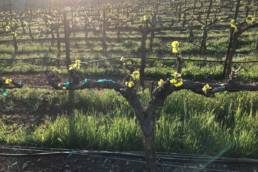FMN – April 2021 – Willamette Valley
Although I preach about drinking diversely and outside one’s comfort zone, sometimes we need to revisit what ignited our passion for wine in the first place; a proverbial palatal homecoming of sorts. I began with bold, extracted red wines and enjoyed them very much, as naturally one would. It was, however, an Oregonian Willamette Valley Pinot Noir that admittedly changed the way I viewed wine forever.
It was not only the burlesque show of aromas and flavors that slowly unveiled themselves to me in a sexy, teasing fashion, but also how these wines truly expressed the place and soil in which they were grown. The exciting aspect about this re-exploration of Oregon is that the top three grapes grown here (Pinot Noir, Pinot Gris and Chardonnay) have all increased in quality and diversified their respective personalities; a terroir lover’s fantasy.
Named for the river that runs through it, Willamette Valley represents Oregon’s largest AVA (American Viticultural Area), spanning from Portland to Eugene, and containing three quarters of all the vineyards in the entire state. There are now nine AVAs located within Willamette Valley, helping to highlight these differing soil compositions, microclimates and overall terroir conditions. Many producers, however, will source grapes and juice from different AVAs, taking full advantage of the expression of each unique terroir and labeling the wines as “Willamette Valley AVA”. Although this may be seen as a venue for lower quality wines in much of Europe, this cross AVA blending remains one of the strong points of Willamette Valley producers.
The importance of differing soils in the Willamette Valley cannot be understated. The valley enjoys a unique historical set of events that resulted in a diversity of soils that would excite even the most stoic of geologist. There are marine sediments (Willakenzie, Bellpine, Chuhulpim, Hazelair, Melbourne, and Dupee soils) laid down from being on the floor of the Pacific Ocean and volcanic basalts (Jory, Nekia, and Saum soils) from the lava flows of eastern Oregon and Idaho. We also see ice age loess (Laurelwood) on northeast-facing hillsides and Missoula flood deposits (Wapato, Woodburn, Willamette) after recurring breaches of the glacial dam. Again, this offers winemakers a broader palate of options with which to create the masterpiece of their final wines.
This cooler climate region enjoys protection on the east by the Cascade Range and from the cool Pacific influence by the Coastal Range to the west. A disruption in the Costal Range called the Van Duzer Gap allows a controlled stream of cool air (without the accompanying bad weather) to funnel into the valley. The far north latitude provides long days allowing grapes to reach phenolic ripeness and their full potential. The wide diurnal temperature range (the difference between daytime and night time temperature) aids the grapes in preserving some of their natural acidity; manifesting as an evident crisp freshness on the palate.
Although the valley found their initial fame through the Burgundian varieties Pinot Noir and Chardonnay, the Pinot Gris and Riesling can be gob-smashingly good. Recent years have seen some interesting strides with Gamay Noir (as seen in Beaujolais) and, with average autumn temps rising, there has been an increase in plantings and quality of Cabernet Franc and Syrah. With the already established quality level of Willamette Valley, one can only postulate that perhaps their spectrum of potential grapes and ultimate success has not yet been fully realized. I, for one, will monitor this progress one glass at a time.
Featured Wineries:
Willamette Valley Vineyards (https://www.wvv.com/)
The seed for Jim Bernau’s dream began with his father giving him sips of wine at the dinner table. Going from home winemaking to more formal training at UC Davis and Beaune, France, Jim returned with a dream of creating something special. In 1981 he began searching for vineyard land and found an overgrown pioneer plum orchard in the Salem Hills, and began planting Pinot Noir in 1983. Stewardship of the land has been a key principle with their winemaking and farming practices. The estate vineyards are certified sustainable through LIVE (Low Input Viticulture and Enology) and Salmon-Safe.
His successes with wine are dwarfed only by his contributions to the Oregon wine industry. Working with the Oregon Winegrowers he helped pass beneficial legislation including allowing the direct shipment of wine, wine tastings in stores and restaurants and the establishment of the Oregon Wine Board. Oregon State University chartered the first professorship for fermentation science in the nation thanks to a personal gift from Jim Bernau.
Suggested Wines:
Estate Pinot Noir 2018 $32
The nose renders a nice balance of red fruit (ripe cherry, currant), baking spice (cinnamon and anise) and a slight coco powder nuance. The palate has a mouth-watering acidity, gently warming alcohol, medium intensity of fruit and soft tannins. Flavors of tart cherry, brambles and baking spice are akin to a rustic cherry pie. The warming finish lingers pleasantly with a baking spiced cherry tart element. Truly an interesting Pinot that would pair with preserved meats (chorizo, sopressata), moussaka, and lamb popsicles with allspice and cumin.
Whole Cluster Pinot Noir 2020 $24
The nose has evident bright candied red fruit (think cherry meets watermelon jolly rancher) and blackberry, cedar and baking spice. The palate explodes with a mix of red and black berries, Indian apple and evident fine grained dusty tannins. A lingering evolving mixed berry fruit finish subtly fades away. The whole cluster, with some carbonic maceration seems to affect the nose more than the palate with the candied fruit. The stem inclusion gives a nice spiciness that continues throughout. Pair with hard nutty cheeses (Manchego), barbecue spare ribs or game bird with berry sauces.
Sweet Cheeks Winery (https://sweetcheekswinery.com/)
Their story began in 1978 when Owner, Dan Smith planted a vineyard on a rolling hillside in Crow, Oregon. While looking at the vineyard he noticed the curious shape of the land (two rounded tops that meet in a tight valley) and christened the vineyard Sweet Cheeks. Initially supplying Pinot Noir, Pinot Gris, Chardonnay and Riesling grapes to local wineries, his focus changed in 2003. A building in Junction City came up for demolition and he relocated it atop the vineyard. Carrying the belief that wine brought about community, he hired his first employee, assistant winemaker Leo Gabica and started the journey. That building later became the tasting room of the winery, opening its doors on Thanksgiving Day 2005.
Truly a family business, Jessica, Dan’s granddaughter, became General Manager in 2016 and Dan’s wife, Beth, took over as President after Dan’s sudden passing in 2018. With the addition of Beth’s daughter, Katie, as Marketing Director and the promotion of Leo as head winemaker, they are continuing to grow and expand their portfolio while staying true to Dan’s mantra, “Sharing a bottle of wine has the power to bring people together, create thoughtful conversation, and change an ordinary day to something to remember.”
Suggested Wines:
Estate Pinot Gris 2018 $27
This wine has a nose with complex aromatics of orchard fruit (white peach nectar), tropical fruit (honeydew), citrus blossom, and sea spray. The palate has a barely noticeable hint of residual sugar and balanced nicely with the salty tang of a brined acidity. The palate demonstrates more tropical citrus and salted melon. The finish begins with the honeydew melon and ends in a seafoam splash. This shows an amalgam of an Italian style and Alsatian style, so let’s call it Willamette Valley style. Honestly, this wine represents one of the best domestic Pinot Gris in recent memory; truly a sexy wine. Pair with tropical fruit salad, creamy charcuterie cheeses, and smoked trout. (2,169 case production)
Estate Series Triple Block Pinot Noir 2016 $37
The wine has a complexity on the nose that takes multiple visits to truly explain. There are elements of subtle red fruit (strawberry, cherry and red currant), earthiness (pencil shavings and dried oolong tea leaves), and baking spices (cinnamon, clove). The dry palate has a bright but restrained acidity, medium intensity and ripe fine grained powdery tannins. The palate has a crunchy ripe red fruit wrapped in an earthy package of dried autumn leaves dusted with baking spices. This wine is truly an amalgam of Burgundy and California with the needle leaning slightly toward the former; elegant and restrained. This is a contemplation (sit and sip) wine but would also pair well with wild mushroom dishes (risotto), duck breast, and country style pâté. (597 case production)
Hazelfern Cellars (https://www.hazelfern.com/)
After college with a business and marketing degree, Bryan Laing lived with his wine-loving aunt and uncle and became hooked on not only the love of wine but the adaptation of it woven into daily life. Their monthly tasting group included some of the founding families of Oregonian wine, greatly influencing the path that Bryan would later travel.
In 2006, with the family’s aid and encouragement, Bryan and his wife Laura started making five gallons of Pinot Noir at a time in their Portland, OR basement. This continued until 2010 when they took the reins and ventured out on their own. The next two vintages proved challenging and much more work than anticipated almost ending their venture. With some soul searching the Laing’s decided to go “all in” starting with the 2013 vintage and developed their Hazel Fern brand; paying homage to the Old Hazel Fern Farm that eventually became their Portland neighborhood.
In 2014, after the tragic death of a female cousin that had beaten cancer just a few years earlier awakened Bryan and Laura to the realization that life is short and they should pursue their dream. Two months later they packed up, went to Chehalem Mountains and with a steep learning curve, began to plant grapes and make wine. Today they want their brand to convey this pursuit of one’s dreams and their wines to be a conduit to connect people from different locations and backgrounds.
Suggested Wines:
Chardonnay Willamette Valley 2018 $39
One first notices the overt nose of tropical fruit (kiwi, cumquat), lemon zest, buttered toasted bread, popcorn kernel, and an herbal note (fresh tarragon). The dry palate is notable for its increased viscous body and bright mouth-watering tropical citrus acidity. Well done in getting the positives from malolactic fermentation without excess diacetyl production (butter flavor). The flavors mirror the nose with a slight tilt toward tropical citrus and a lingering bright acidic freshness that meanders on the finish. The acidity elevates this to a great food wine for richer foods that need a slight cleansing between bites. Pair with lobster in butter, lemon pepper chicken, or pan seared scallops with tarragon butter. (175 case production)
Pinot Noir Willamette Valley 2018 $39
The nose has a rich ripe fruit forward element (elderberry, raspberry, red currant), baking spices (allspice, cinnamon), cigar box, pencil shavings, and black tea leaves. The dry palate has a crunchy red fruit acidity, medium body, evident fine grained tannins. This is reminiscent of a savory baked berry tartlet with more overt earthy notes on the palate vs the nose. The finish allows the red fruit to slowly fade with the earthy tea leaf lingering. The blend of fruit and earth is why these Pinot Noirs keep me coming back. Pair with game bird, cured meat (prosciutto), Moroccan tagine chicken. (375 case production)
** All wines provided by respective wineries as tasting samples **




